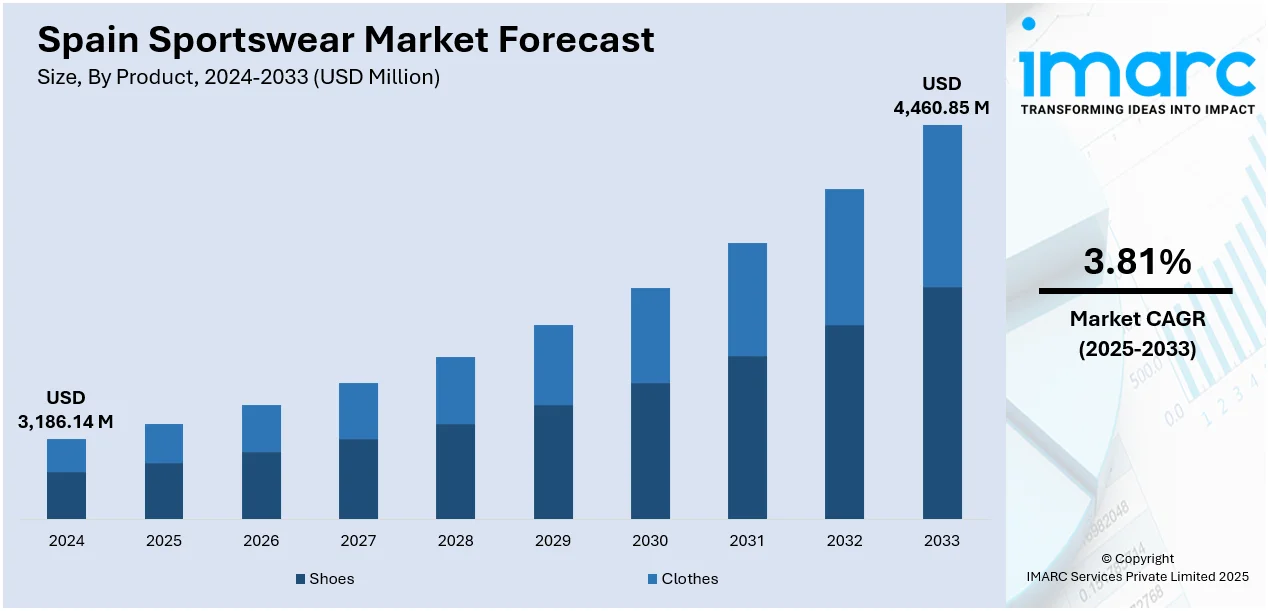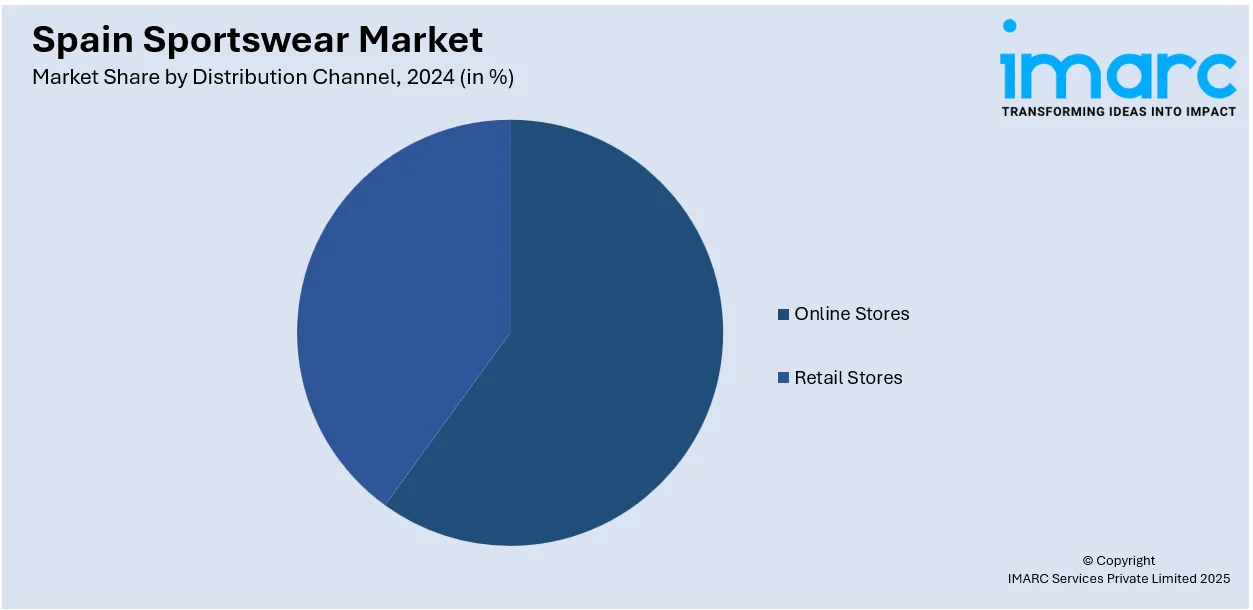
Spain Sportswear Market Size, Share, Trends and Forecast by Product, Distribution Channel, End User, and Region, 2025-2033
Spain Sportswear Market Overview:
The Spain sportswear market size reached USD 3,186.14 Million in 2024. Looking forward, the market is expected to reach USD 4,460.85 Million by 2033, exhibiting a growth rate (CAGR) of 3.81% during 2025-2033. The market is witnessing steady growth fueled by rising fitness participation, regional sports enthusiasm, and expanding fashion-sport crossover trends. Consumer demand is shifting toward versatile, performance-oriented sports apparel suitable for both exercise and everyday use. This, along with the presence of global and local brands further intensifies competition, fostering innovation and accessibility across segments. This dynamic environment is shaping the Spain sportswear market share.
|
Report Attribute
|
Key Statistics
|
|---|---|
|
Base Year
|
2024
|
|
Forecast Years
|
2025-2033
|
|
Historical Years
|
2019-2024
|
| Market Size in 2024 | USD 3,186.14 Million |
| Market Forecast in 2033 | USD 4,460.85 Million |
| Market Growth Rate 2025-2033 | 3.81% |
Spain Sportswear Market Trends:
Growth in Sports Tourism and Event Participation
Spain’s robust sports tourism sector, including football, triathlons, and cycling events, significantly elevates demand for high-performance sportswear. Domestic and international travelers attending marathons, sports camps, and outdoor recreation in regions such as Catalonia, Andalusia, and the Costa del Sol often shop for technical clothing suited to local climates and training needs. Major events like the Madrid Marathon or regional training festivals draw athletes who prioritize durable, breathable, and functionally advanced apparel. The influx of visitors encourages brands to stock event-specific apparel and accessories. Furthermore, sports tourism creates seasonal spikes for retailers that cater to performance needs, strengthening sales and local brand exposure. This tourism-driven demand plays a vital role in expanding Spain’s overall sportswear ecosystem.

To get more information on this market, Request Sample
Climate-Driven Product Innovation and Seasonal Adaptation
Spain’s diverse climate, from cold northern regions to Mediterranean and desert-like southern zones, shapes consumer requirements for adaptable sportswear. Brands are developing climate-specific lines such as UV-resistant activewear for southern regions and thermal, moisture-wicking fabrics for the cooler north. This geography-driven diversity inspires innovation in materials, ventilation, and weight design. As a result, Spanish consumers expect adaptable sports apparel optimized for temperature, humidity, and activity type. Domestic designers and international labels alike customize collections by region, ensuring relevance in seasonal retail cycles. The desire for specialized garments, like breathable summer running gear, layering for cooler months, and lightweight hiking attire, fuels both product development and market segmentation.
Cultural Integration of Team Sports and Club Apparel
Spain’s strong heritage in team sports, especially football, basketball, and futsal, deeply influences sportswear consumption through club apparel and fan gear. Consumers frequently purchase branded jerseys, fan shirts, and associated club merchandise alongside regular athletic wear. Local sports clubs and amateur leagues reinforce brand loyalty at community levels, with coordinated kits and exclusive fan clothing lines. This cultural integration extends to schools and regional leagues, where uniforms and branded gear are mandatory. Sportswear providers that secure partnerships or licensing deals with professional clubs gain major exposure and consistent revenue streams. The pride of supporting regional teams and participating in club culture strengthens the market for both officially licensed apparel and community-aligned sportswear offerings.
Spain Sportswear Market Segmentation:
IMARC Group provides an analysis of the key trends in each segment of the market, along with forecasts at the country and regional levels for 2025-2033. Our report has categorized the market based on product, distribution channel, and end user.
Product Insights:
- Shoes
- Clothes
The report has provided a detailed breakup and analysis of the market based on the product. This includes shoes and clothes.
Distribution Channel Insights:

- Online Stores
- Retail Stores
A detailed breakup and analysis of the market based on the distribution channel have also been provided in the report. This includes online stores and retail stores.
End User Insights:
- Men
- Women
- Kids
A detailed breakup and analysis of the market based on the end user have also been provided in the report. This includes men, women, and kids.
Regional Insights:
- Northern Spain
- Eastern Spain
- Southern Spain
- Central Spain
The report has also provided a comprehensive analysis of all the major regional markets, which include Northern Spain, Eastern Spain, Southern Spain, and Central Spain.
Competitive Landscape:
The market research report has also provided a comprehensive analysis of the competitive landscape. Competitive analysis such as market structure, key player positioning, top winning strategies, competitive dashboard, and company evaluation quadrant has been covered in the report. Also, detailed profiles of all major companies have been provided.
Spain Sportswear Market News:
- In June 2024, American brand Original Penguin officially entered the Spanish market by launching its debut flagship retail store in Madrid. Located in the upscale Barrio Salamanca district, the newly opened outlet showcases the brand’s full collection of men’s sportswear apparel. It also features a wide array of accessories, such as loungewear, headwear, leather items, and underwear.
Spain Sportswear Market Report Coverage:
| Report Features | Details |
|---|---|
| Base Year of the Analysis | 2024 |
| Historical Period | 2019-2024 |
| Forecast Period | 2025-2033 |
| Units | Million USD |
| Scope of the Report |
Exploration of Historical Trends and Market Outlook, Industry Catalysts and Challenges, Segment-Wise Historical and Future Market Assessment:
|
| Products Covered | Shoes, Clothes |
| Distribution Channels Covered | Online Stores, Retail Stores |
| End Users Covered | Men, Women, Kids |
| Regions Covered | Northern Spain, Eastern Spain, Southern Spain, Central Spain |
| Customization Scope | 10% Free Customization |
| Post-Sale Analyst Support | 10-12 Weeks |
| Delivery Format | PDF and Excel through Email (We can also provide the editable version of the report in PPT/Word format on special request) |
Key Questions Answered in This Report:
- How has the Spain sportswear market performed so far and how will it perform in the coming years?
- What is the breakup of the Spain sportswear market on the basis of product?
- What is the breakup of the Spain sportswear market on the basis of distribution channel?
- What is the breakup of the Spain sportswear market on the basis of end user?
- What is the breakup of the Spain sportswear market on the basis of region?
- What are the various stages in the value chain of the Spain sportswear market?
- What are the key driving factors and challenges in the Spain sportswear market?
- What is the structure of the Spain sportswear market and who are the key players?
- What is the degree of competition in the Spain sportswear market?
Key Benefits for Stakeholders:
- IMARC’s industry report offers a comprehensive quantitative analysis of various market segments, historical and current market trends, market forecasts, and dynamics of the Spain sportswear market from 2019-2033.
- The research report provides the latest information on the market drivers, challenges, and opportunities in the Spain sportswear market.
- Porter's five forces analysis assist stakeholders in assessing the impact of new entrants, competitive rivalry, supplier power, buyer power, and the threat of substitution. It helps stakeholders to analyze the level of competition within the Spain sportswear industry and its attractiveness.
- Competitive landscape allows stakeholders to understand their competitive environment and provides an insight into the current positions of key players in the market.
Need more help?
- Speak to our experienced analysts for insights on the current market scenarios.
- Include additional segments and countries to customize the report as per your requirement.
- Gain an unparalleled competitive advantage in your domain by understanding how to utilize the report and positively impacting your operations and revenue.
- For further assistance, please connect with our analysts.
 Request Customization
Request Customization
 Speak to an Analyst
Speak to an Analyst
 Request Brochure
Request Brochure
 Inquire Before Buying
Inquire Before Buying




.webp)




.webp)












